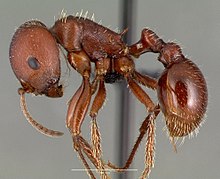Pogonomyrmex
| Pogonomyrmex | |
|---|---|
 |
|
| P. barbatus worker | |
| Scientific classification | |
| Kingdom: | Animalia |
| Phylum: | Arthropoda |
| Class: | Insecta |
| Order: | Hymenoptera |
| Family: | Formicidae |
| Subfamily: | Myrmicinae |
| Tribe: | Pogonomyrmecini |
| Genus: |
Pogonomyrmex Mayr, 1868 |
| Type species | |
|
Formica badia |
|
| Diversity | |
| 69 species | |
| Synonyms | |
|
Ephebomyrmex Wheeler, 1902 |
|
Ephebomyrmex Wheeler, 1902
Forelomyrmex Wheeler, 1913
Janetia Forel, 1899
Pogonomyrmex is a genus of harvester ants, occurring primarily in the deserts of North, Central, and South America, with a single endemic species from Haiti.
The genus name originated from the Greek language and refers to a beard-like structure, the psammophore, below the head (Greek πώγων/pōgōn, "beard" + μύρμηξ/murmēx, "ant"), which can be found in most species of the subgenus sensu stricto. The psammophore is used for gathering small seeds, helping to increase the efficiency of transportation of fine sand and pebbles during nest construction, or to carry eggs. However, this structure is missing in species of the subgenus Ephebomyrmex (Greek ἔφηβος/ephēbos, "beardless lad"), and these species generally have smaller individuals and colonies.
Pogonomyrmex (sensu stricto) workers have the most toxic venom documented in any insects, with Pogonomyrmex maricopa being the most toxic tested thus far. It has an LD50 of only 0.12 mg/kg, compared to western honey bee venom, at 2.8 mg/kg, and comparable to cobra venom. The venom is presumed to be an antivertebrate defense, specifically against predators that have evolved to selectively feed on them such as horned lizards. Very few insects have had the toxicity of their venoms formally tested, and other insects likely have more potent venoms.
These ants dig very deep nests with many underground chambers in which they keep seeds, from which they derive food for their larvae. The areas around most Pogonomyrmex (sensu stricto) nests tend to be utterly devoid of vegetation, and are easily seen from a distance.
...
Wikipedia
